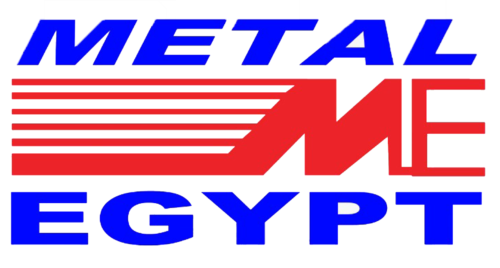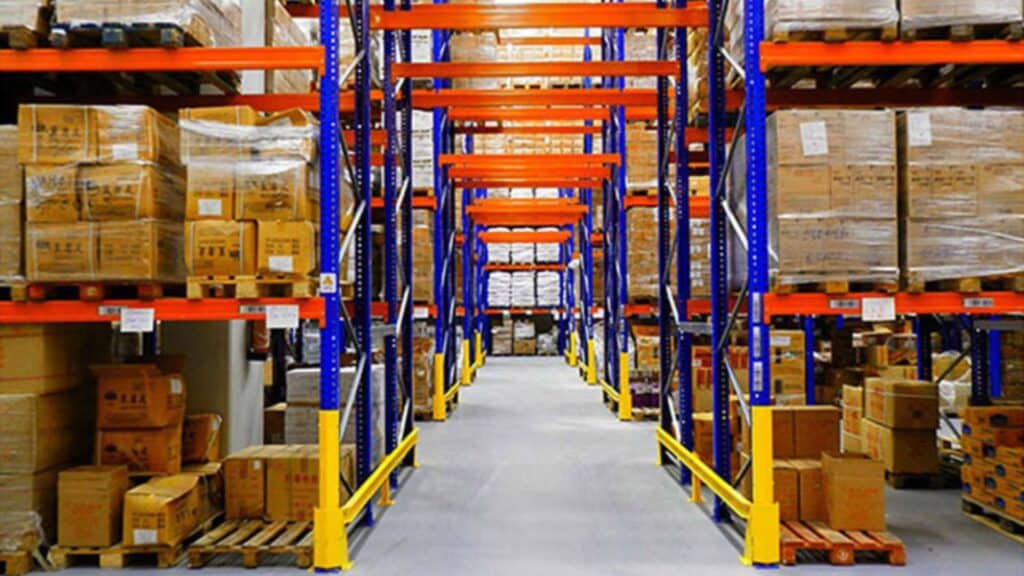Pallet storage systems refer to various methods and structures designed to efficiently store and organize palletized goods in a warehouse or distribution center. Pallets are flat structures with both a top and bottom deck, commonly used for transporting goods in a supply chain. Pallet storage systems are crucial for optimizing space, improving accessibility, and streamlining inventory management. Several types of pallet storage systems exist, each with its advantages and suitable applications. Some common pallet storage systems include:
Selective Pallet Racking:
- This is the most common and straightforward pallet storage system.
- Pallets are stored on horizontal beams on multiple levels, allowing easy access to each pallet individually.
- It is suitable for businesses with many products and low pallet quantities per SKU (Stock Keeping Unit).
Drive-In and Drive-Through Racking:
- These systems involve deeper pallet storage with fewer aisles.
- Drive-In Racking has one entrance and exit, while Drive-Through Racking has access on both ends.
- Suitable for businesses with high-volume storage of similar products.
Push-Back Racking:
- Pallets are stored on nested carts or rails, and when a new pallet is loaded, it pushes the existing pallets back.
- Ideal for Last-In-First-Out (LIFO) inventory systems.
Pallet Flow Racking:
- Pallets are loaded on one end and slide down inclined roller tracks, allowing for automatic stock rotation (First-In-First-Out or FIFO).
- It is suited for perishable goods or products with expiration dates.
Cantilever Racking:
- Designed for the storage of long and bulky items, such as pipes, lumber, or furniture.
- Pallets are replaced with arms or beams that extend from vertical columns.
Mobile Racking:
- Pallet racks are mounted on motorized mobile bases that can move laterally.
- Maximizes storage capacity by eliminating unnecessary aisles.
Automated Storage and Retrieval System (AS/RS):
- It involves the use of automated machinery, such as robotic arms or cranes, to handle the storage and retrieval of pallets.
- Enhances efficiency and reduces the need for human intervention.
The choice of a pallet storage system depends on factors such as the type of products stored, storage capacity requirements, inventory turnover, and the available space in the warehouse. Implementing an appropriate pallet storage system is crucial for optimizing warehouse operations and ensuring the efficient movement of goods within the supply chain.
the different types of pallet racking systems
There are several types of pallet racking systems, each designed to meet specific storage needs and optimize warehouse space. Here are some common types of pallet racking systems:
Selective Pallet Racking:
- This is the most common and widely used pallet racking system.
- Pallets are stored on horizontal beams, and each pallet has direct access to the aisle.
- It’s suitable for businesses with a high number of SKUs and a low volume of each SKU.
Drive-In and Drive-Through Racking:
- Drive-In and Drive-Through racking systems allow forklifts to drive directly into the rack.
- In Drive-In systems, there is one entry point, while in Drive-Through systems, there are entry and exit points on opposite ends.
- These systems are ideal for storing large quantities of the same SKU and operate on a Last-In-First-Out (LIFO) inventory basis.
Push-Back Racking:
- Pallets are loaded onto a series of nested carts or inclined rails.
- When a new pallet is loaded, it pushes the previously loaded pallet back, creating a dynamic storage system.
- Suited for Last-In-First-Out (LIFO) inventory rotation.
Pallet Flow Racking:
- Pallets are loaded on one side and flow down inclined rollers or wheels to the other side.
- Allows for automatic stock rotation based on a First-In-First-Out (FIFO) system.
- Well-suited for high-density storage and perishable goods.
Cantilever Racking:
- Designed for the storage of long and bulky items, such as pipes, lumber, or furniture.
- Features arms or beams that extend from vertical columns, providing easy access to items.
Double Deep Racking:
- Similar to selective pallet racking but with pallets stored two deep.
- Requires specialized forklifts with extended reach for accessing the second pallet in each row.
Mobile Racking:
- Pallet racks are mounted on motorized mobile bases that move along tracks on the floor.
- Eliminates the need for multiple aisles, maximizing storage space.
Selective Pallet Flow Racking:
- Combines the selectivity of selective racking with the dynamic storage flow of pallet flow racking.
- Suitable for applications where selectivity and high-density storage are both important.
Automated Storage and Retrieval System (AS/RS):
- It involves the use of automated machinery, such as robotic arms or cranes, to handle the storage and retrieval of pallets.
- Maximizes efficiency and reduces the need for manual labor.
Choosing the right pallet racking system depends on factors such as the type of products stored, inventory turnover, available space, and handling equipment. Each system has its advantages and is suited to specific warehouse requirements.
What is the most common pallet racking system?
The most common pallet racking system is the Selective Pallet Racking system. This system is widely used across various industries and is characterized by its simplicity and accessibility. In selective pallet racking:
- Pallets are stored on horizontal beams, and each pallet has direct access to the aisle.
- Forklifts or pallet jacks can easily maneuver between the aisles to retrieve or place pallets.
- It allows for quick and direct access to any pallet, making it suitable for businesses with many products and a low volume of each SKU (Stock Keeping Unit).
The popularity of selective pallet racking can be attributed to its versatility and ease of use. It is well-suited for warehouses with a diverse product range where quick and frequent access to individual pallets is essential. Additionally, selective pallet racking is often considered cost-effective compared to some specialized racking systems.
However, it’s important to note that the choice of a pallet racking system depends on specific operational requirements, such as the type of products stored, storage density needs, and the flow of goods in the warehouse. Different businesses may opt for alternative systems, such as drive-in, push-back, or pallet flow racking, based on their unique storage and handling requirements.
Pallet storage systems price factors
The cost of a warehouse racking system can vary significantly based on several factors. When considering the price of a racking system, it’s important to take into account the following factors:
Type of Racking System:
Different types of racking systems have varying costs. For example, selective pallet racking tends to be more cost-effective compared to automated storage and retrieval systems (AS/RS) or specialized systems like pallet flow racking.
System Design and Configuration:
- The specific design and configuration of the racking system will impact the cost. This includes factors such as the height of the racks, the number of levels, aisle width, and the overall layout of the warehouse.
Storage Density Requirements:
- High-density storage systems, such as drive-in racking or push-back racking, often come with a higher price tag compared to systems with lower storage density. These systems maximize storage space but may require more complex designs and construction.
Material and Construction:
- The materials used in the construction of the racking system, as well as the overall build quality, will influence the cost. Heavy-duty materials and robust construction may result in a higher initial investment but can provide long-term durability and stability.
Size and Space Utilization:
- The size of the warehouse and the space available for the racking system play a crucial role in determining costs. Larger warehouses may require more extensive systems, impacting the overall price.
Installation Costs:
- The cost of installation, including labor and any necessary permits, is a significant factor. Complex installations or specialized systems may require more skilled labor, affecting the overall cost.
Accessibility and Handling Equipment:
- The type of handling equipment used in conjunction with the racking system can influence costs. For example, if a specialized forklift is required for a particular system, the cost of that equipment should be considered.
Safety Features and Compliance:
- Compliance with safety regulations and the inclusion of safety features can impact costs. Investing in safety features, such as rack guards and seismic considerations, is crucial for ensuring a secure and compliant system.
Supplier and Location:
- The choice of supplier and geographic location can affect prices due to variations in labor costs, shipping expenses, and local market conditions.
Customization and Additional Features:
- Customization of the racking system to meet specific needs and the inclusion of additional features, such as anti-collapse mesh, may incur additional costs.
It’s essential to work closely with a racking system supplier or manufacturer to assess your specific warehouse requirements and receive a detailed quote based on your unique needs. Additionally, consider the long-term benefits and return on investment when evaluating the cost of a warehouse racking system.
Metal Egypt brings a wealth of expertise to the production and distribution of pallet storage systems designed for warehouses. We take pride in delivering outstanding service, as evidenced by positive customer testimonials throughout the communication and site visitation process, pricing negotiations, and the subsequent stages of manufacturing and supply.
Our unwavering commitment is to ensure customer satisfaction. Feel free to reach out to us without hesitation to schedule a complimentary site visit, where we can provide comprehensive pricing tailored to your specific requirements.

